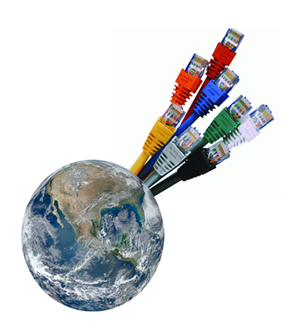Judul : Various Flavors of Business Internet Access
link : Various Flavors of Business Internet Access
Various Flavors of Business Internet Access
Author: John SheplerYou may think that the Internet is the Internet, but the way you connect has a lot to do with the productivity you find. What's your best bet? Is Internet access dedicated or shared?
 What is dedicated internet access?
What is dedicated internet access?Actually, there are two ways to connect to the Internet. One is Internet access, which is the backbone of most consumer and wireless services. Another is Dedicated Internet Access, or DIA.
Dedicated access is similar to managing your internal network. You own and control your bandwidth. No other company can come in and take your bandwidth. When you allow vendors or customers to connect to your network, you control that access and decide what resources they can use.
You do not own the internet. Nobody does. The backbone of the Internet is high-bandwidth infrastructure provided and managed by Tier 1 carriers. Smaller carriers and local ISPs pay for traffic to pass through the core. What you need is a performance that is closest to what happens at the core. This is a special login.
How does dedicated internet access work?
They order from an established or competing network operator that has its network core connected to the Internet core. All traffic on this line is under your control. When you access a carrier's network, you rely on their expertise and rich resources to ensure you have enough bandwidth without congestion, latency, jitter or packet loss.
Isn't shared internet access more convenient?
Shared Internet access is a much cheaper option for one simple reason. it is shared. Here's how it works. An ISP that sells directly to consumers and small businesses leases a dedicated Internet access line, usually a fiber optic line, with relatively high bandwidth. That provider then multiplexes, or shares, that bandwidth among many customers. The maximum bandwidth you can use is limited by the data plan you purchased.
Actual throughput will of course depend on how many other clients are on the network at the same time and what they are doing. It allows many users to surf the web without slowing each other down. When many users download videos or large files from cloud providers, the total bandwidth exceeds the bandwidth of the provider's line, and each customer receives only a fair share of that line. ISPs can't provide enough bandwidth for the worst traffic conditions and keep the price reasonable, so you can expect your bandwidth to fluctuate.
So you will have to make a decision. If you don't use cloud services or need consistently high performance to keep your employees productive, you can take advantage of the cost savings of cable broadband, satellite or mobile broadband.
Even more performance when needed
The Internet is the Internet, and it's designed to maintain reliable connections and not focus on bandwidth, latency, or security. Even in the core, congestion can occur and performance can vary from minute to minute. Even a special access line cannot change the nature of this public resource.
One way to improve network performance over long distances is to avoid connecting to the Internet for things you don't need. Do you have a direct connection to a cloud service provider for business processes and of course VoIP telephony or unified communications? Use point-to-point private lines to connect business locations outside of your home. An MPLS network, a type of Internet exchange, is usually an acceptable choice. There are multiple users on this network, but the network operates in such a way that each client has all the resources it needs. MPLS networks are not connected to the general public, so you still need the Internet to communicate with most customers.
A new technology that is increasing the efficiency of the Internet is SDN or Software Defined Networking, also called SD-WAN or Software Defined Wide Area Network. It is a system that integrates and manages multiple Internet access lines to allocate the best performing paths for the most important functions. You can connect a dedicated T1 or Ethernet line, a cable broadband line, a 4G or 5G wireless modem, or a two-way satellite receiver and let the SD-WAN organization decide which packets go where. This gives you redundancy so that you have access to the Internet almost all the time and can cost less than a dedicated high-speed line that is not in constant use.
How should you connect to the Internet? Dedicated or shared internet works better. Find out what bandwidth options and prices are available for your business.


That's the article Various Flavors of Business Internet Access
That's it for the article Various Flavors of Business Internet Access this time, hopefully can be useful for all of you. okay, see you in another article post.
You are now reading the article Various Flavors of Business Internet Access with link address https://direcway-satelite.blogspot.com/2022/08/various-flavors-of-business-internet.html

0 Response to "Various Flavors of Business Internet Access"
Posting Komentar